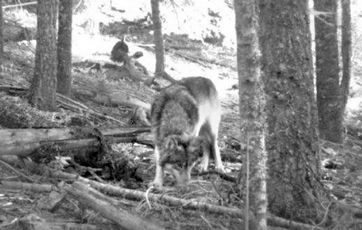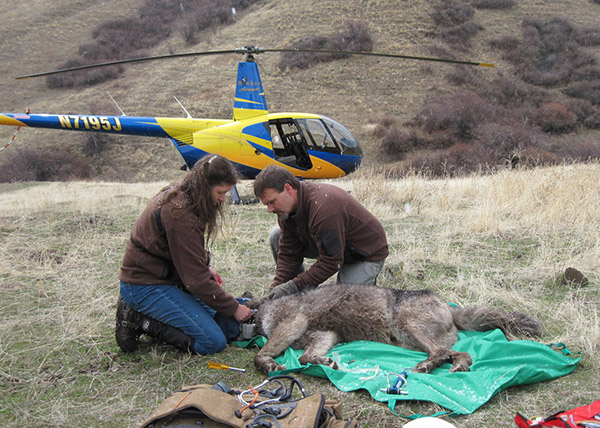
By whatever name he’s known, the story of Journey (OR-7) has captured imaginations around the world. It’s but a chapter in the broader story of wolf recovery. And like that bigger story, the end is uncertain. As a number of news outlets have recently noted, the battery that has powered the collar that made Journey famous just outlived its life expectancy.
Any day now, the battery that has sent signals to a satellite and back down to earth may fail; leaving a collared wolf - unconcerned with his name or what people think of him - to continue on with his day-to-day life.
COLLARS
The public agencies responsible for wolf conservation in Oregon and California, where Journey has split time in recent months, have reportedly decided not to replace his collar. The public they serve have understandably mixed feelings on the value and ethics of collaring.
 Collars are expensive. The process of collaring is dangerous for the animals and people. Helicopters crash and one Oregon wolf has already died as a result of a collaring operation. Collars can make wolves targets of poachers, hunters, and government agents alike. Some would call “wildlife management” the ultimate oxymoron, and there’s a legitimate question of how wild is wildlife with collars and ear tags.
Collars are expensive. The process of collaring is dangerous for the animals and people. Helicopters crash and one Oregon wolf has already died as a result of a collaring operation. Collars can make wolves targets of poachers, hunters, and government agents alike. Some would call “wildlife management” the ultimate oxymoron, and there’s a legitimate question of how wild is wildlife with collars and ear tags.
On the flip side, collars can efficiently provide information that helps the understanding and conservation of native wildlife. The data can help focus efforts to reduce conflict between wildlife and humans and make them more effective.
Though new tools like DNA analysis, trail cameras and old school tracking can provide a lot of great information, collars remain a useful tool with a place in modern wildlife management.
A WOLF WITHOUT A COLLAR
Whatever one’s views on collaring, OR-7 wouldn’t be much of a story without it. Publicly known photos and confirmed sightings are scarce. There may be as few as one photo of the history-making wolf taken without the assistance of the collars signal – a grainy image from a hunters trail camera.
Without that collar, California could still be waiting for its first wolf in nearly a century.
Despite recent confirmation of wolf tracks on the flanks of Mt. Hood and the “Santiam Wolf” sighting of 2009, those wolves remain enigmatic characters in the story of wolf recovery. Journey on the other hand has become a true ambassador. The wolves in either story may have traveled even further than Journey. They may be in California, Canada, Cannon Beach, or the Cascades. Wolves live difficult lives. Whether from a poachers bullet, a speeding car, the kick of an elk, or the slow death of starvation, it’s just as possible those stories have already ended.
For me, that’s my favorite part of the story of OR-7. While most headlines focus on conflict, controversy, and politics, the story of Journey was a welcome respite. It was an opportunity for once to focus on the reality of wolves. Anthony Miles once said “Wolves may feature in our myths, our history, and our dreams, but they have their own future, their own loves, their own dreams to fulfill.” I can’t say whether or not wolves have dreams, but there’s something to that.
THE MORAL OF THE STORY
Journey’s adventure resonated with people for different reasons. Writing for Orion Magazine, Joseph Donnelly pointed out his story is easy to relate to for many males of the two-legged variety. After growing up in a tight knit family, he went out looking for love and adventure.
For conservationists, the story was a validation of decades of work to protect the big wild places wolves and other wildlife – say nothing of humans – need to thrive. His trail wound through wilderness and roadless areas protected by decades of dogged determination. Especially in a rapidly changing world, his time spent in threatened landscapes and the unprotected wilderness areas near Crater Lake was a stark reminder of the importance of the need to carry on that legacy.
Where wildlife appreciators see a story of redemption in wolf recovery, there are of course still a few who see the return of an old foe. Journey, his fan club, and the very idea of the wild – represent a threat once nearly eliminated from the landscape. It represents a change in the fabric of our society from a dream of manifest destiny and limitless resources to an appreciation that we may be destroying what we need in the hopes of gaining more of what we think we want.
For those who see profit in such division, wolves continue to provide a useful wedge to drive apart the conservation community from the hunting community and rural from urban. Why else would the Koch Brothers have funded a video that makes OR-7 the focal point of government conspiracy theory and organize town hall meetings tying wolf recovery to Obamacare?
To bureaucrats in California reluctant to create a state plan or wildlife managers who feel caught in the middle, the idea of a celebrity wolf is a major inconvenience.
HAPPILY EVER AFTER?
Oblivious to those who demonize, sanctify, study, hunt, and manage them, is the wolf. A wolf that sleeps. A wolf that hunts. A wolf that howls. And a wolf that wanders.
 When that wolf wears a collar, sometimes it’s news. So, as the battery in Journey’s collar wanes and he fades from celebrity into obscurity, it’s a good time to reflect.
When that wolf wears a collar, sometimes it’s news. So, as the battery in Journey’s collar wanes and he fades from celebrity into obscurity, it’s a good time to reflect.
The story of wolves in America had a violent beginning. For most Americans, their return has been a story of redemption. And – because he wore a collar – OR-7 has been a symbol of that hope. To his credit, he’s been a good ambassador for his kind.
As states like Idaho continue to kill wolves by the hundreds and the Obama administration continues to push a plan to strip wolves like OR-7 of basic protections, the ending of the story of wolf recovery in America is uncertain. Will it have a happy ending or will it circle back to its violent past?
More than likely, it will be somewhere in the middle. The story is a long way from finished, and it’s ending is in our hands.
Even for those who still fear and vilify wolves, it’s hard not to have a sense of begrudging admiration for OR-7. For those who hate the idea of a celebrity wolf – or any wolf – and for those fearful for his well-being, the news of the death of OR-7’s collar may be a relief. For those who want a wolf finder in the southern cascades or want to follow his every move, it’s a loss.
But ultimately, once Journey’s collar dies, we may never know his fate. The way I see it, that might be okay. Sometimes it’s good to have a little mystery left in the world.
**UPDATE** Wolves - including Journey - never cease to surprise! It appears OR-7 has likely found a mate and it is very likely wildlife agencies will replace his collar and try to collar his possible mate.
 '
'
